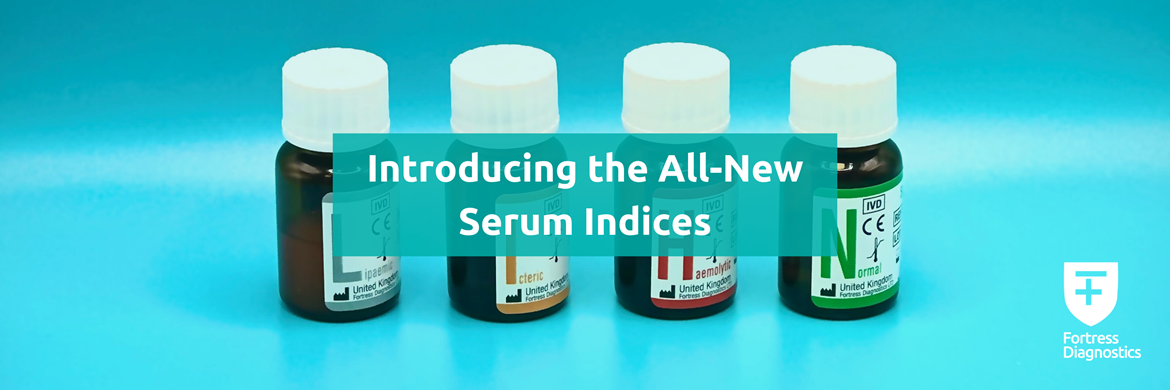
05 January, 2024
Introducing the all-new Serum Indices! The Fortress Serum Indices are the perfect tools to aid in the monitoring of instrument detection of lipaemia, icterus and haemolysis in specimens.
Introduction
Analytical interference refers to any factor that influences the accuracy, precision, or reliability of lab results, and as such, deviating from the true value of the analyte caused by the presence of endogenous or exogenous substance. Studying the impact of endogenous substances like bilirubin, haemoglobin and lipids on clinical laboratory assays is crucial to ensure the accuracy and reliability of test results. Analytical interferences caused by haemolysis, icterus and lipaemia can affect the outcomes of chemistry assays performed in clinical laboratories and is the most common analytical interference observed in the clinical laboratory 1.
Automated chemistry analysers often have built-in features to detect certain interferences, such as haemolysis, icterus and lipaemia, in samples. These analysers can flag samples that exhibit high levels of these substances, alerting laboratory personnel to potential interferences and enabling them to take appropriate action. But, if you don’t have an automated chemistry analyser, what other options are available?
Introducing the All-New Fortress Serum Indices
Features & Benefits
- Enhancing specimen integrity
- Prepared from human source material
- Available in lyophilised and liquid frozen formats
- Compatible with a wide range of leading chemistry instruments
- Improves the identification of pre-analytics interferences
- Long shelf life to reduce frequency of lot change
- Monitors instrument response to detecting lipaemic, icteric or haemolysed samples
Stability
|
When stored at -20 to -80oC
|
24 months
|
|
Frozen aliquot at -20 to -80oC
|
30 days
|
|
Open vial stability at +2 to +8oC
|
14 days
|
|
Unopen vial stability at +2 to +8oC
|
14 days
|
Ordering Details
|
Cat. Number
|
Levels
|
Pack Size
|
|
BXC0600A
|
LIHN
|
4 x 1 x 5ml
|
|
BXC0600C
|
LIH Lipaemic
|
4 x 5ml
|
|
BXC0600D
|
LIH Icteric
|
4 x 5ml
|
|
BXC0600E
|
LIH Haemolytic
|
4 x 5ml
|
|
BXC0600B
|
LIH Normal
|
4 x 5ml
|
Product Information
Interference caused by lipaemia, icterus and haemolysis (LIH) which affect sample integrity is one of the most common problems observed in all clinical laboratories.
Accurately measuring LIH interference levels in specimens is directly related to obtaining accurate results and to delivering the correct patient care.
Historically, laboratories performed manual serum indices detection by visually inspecting samples.
Most automated analytical platforms now have the ability to accurately measure LIH using photometric methodology, to provide qualitative or semi-qualitative results. This not only ensures uniformity but also removes subjective variability.
Fortress Serum Indices Quality Controls are designed to monitor the ability of an instrument to accurately measure LIH in specimens. This is done through the use of controls which mimic specimens considered as either lipaemic, icteric, haemolytic or normal using human based control material.
Clinical Laboratories can encounter samples that show significant Lipaemia, Icterus and Haemolysis all of which, if high enough, can cause interference with clinical assays. Several diseases, diet and pre-analytical conditions can cause increased concentrations of chromogens like bilirubin, haemoglobin and lipids in serum/plasma.
The use of serum indices allows a laboratory to critically evaluate the LIH interference level of a sample and to make a decision as to whether or not a result has been potentially compromised resulting in an incorrect result being reported.
The laboratory’s quality of reporting can be kept to a high standard by treating LIH indices as another quantitative assay which require quality control to ensure reproducibility and reliability.
References
- Akbas N, Eppert B, Miller J, Schulten C, Wallace C, et al. Effect of Hemolysis, Icterus and Lipemia on Chemistry Tests and Association between the Amount of Interfering Substances and LIH Indices . chrome-extension://efaidnbmnnnibpcajpcglclefindmkaj/https://www.medpace.com/wp-content/uploads/2018/08/Whitepaper-LIH.pdf (accessed 13 December 2023).








